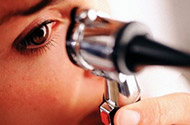Near-sightedness (myopia)
Near-sightedness is optic disorder in the work of the eye, when the visual acuity for far distances is deteriorated.
How does a person see? The eye performs the function of a high precision "camera with multifocal lenses". When we look at an object, the rays of natural or artificial light are reflected on its surface. The rays pass the anterior part of the eye and are reflected by the system of eye lenses; then they get inside the eyebulb through the pupil and are focused in one point on the posterior pole of the eye, covered by the nervous tunic - the retina.
Near-sightedness is accompanied by the impairment of focusing of light waves on the retina, leading to blurred distance vision. Most frequently the form of the eye is changed due to specific reasons: it is lengthened. Therefore, it looks as if the focusing point is not reaching the retina, instead, it occurs right in front of it, thus smearing the image.
Kinds of near-sightedness:
- congenital;
- genetic;
- acquired.
Congenital and genetic near-sightedness is often revealed as early as in childhood. A child inherits a specific (elongated) form of the eyebulb along with the form of the nose, lips, eyes, etc., i.e. the form of the eyes is a phenotypic feature (the feature of affinity to one's ancestors).
Acquired near-sightedness starts with visual workload for short distances at the age of 7–16 years old. Bad light, incorrect body position while reading and writing, excessive use of computer, TV, games on a cell phone – all these bring excessive workload to a child's eye, creating favorable conditions for anatomic changes.
There are three degrees of shortsightedness, depending on which doctors distinguish different anatomic and functional changes:
- low degree – near-sightedness to –3.0 diopters;
- medium degree – near-sightedness to –6.0 diopters;
- high degree – near-sightedness over –6.0 diopters.
Most often the low degree of near-sightedness is adaptive. It does not bear the risk of sudden loss of vision or any malignancy, and thus requires mere correction and observation.
Undesired changes on the fundus of the eye are possible for medium and high degrees of near-sightedness. Due to excessive overdistension of the eyebulb the retina is overdistended and thinner, with sites of impaired trophism. Correction may not achieve the desired effect; there is a possibility of such complications as ruptures and retinal detachment. These stages of the disease require closer attention of both the patient and the doctor, including obligatory dilated eye examinations, correction, courses of conservative supportive care, and preventive laser coagulation of the retina, if required.
It should be remembered that near-sightedness is an incurable disease, as it is impossible to shorten the eyebulb. Near-sightedness may only be corrected.
Correction methods:
- correction with eyeglasses;
- correction with contact lenses (hard, soft, Paragon night lenses);
- refractive laser correction (LASEK, LASIK).
Correction with eyeglasses may be prescribed since the early childhood. Correction with contact eyelenses requires taking care of lenses, thus the child's readiness and maturity are taken into consideration.
Refractive surgery is laser correction of near-sightedness, performed at the age of 18, at the patient's request and with no contraindications.
In case of any pathological changes on the fundus of the eye it is obligatory to perform restorative preventive laser coagulation of the retina, which decreases the risk of possible blindness considerably.










